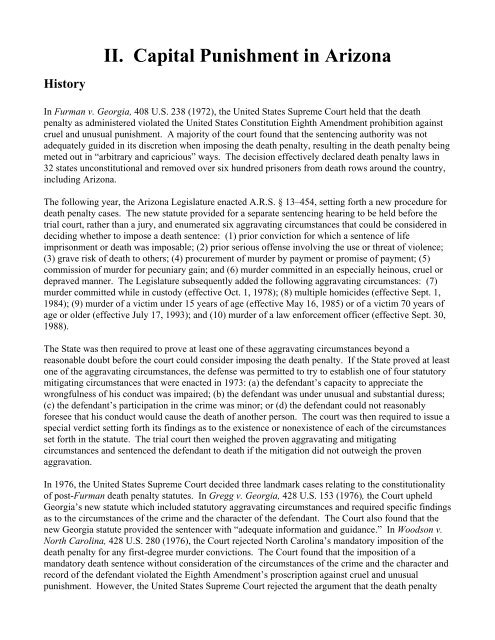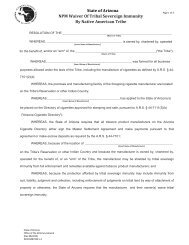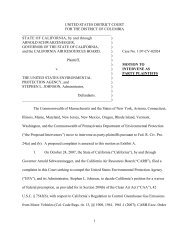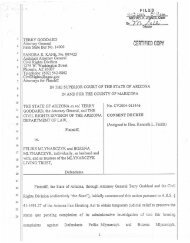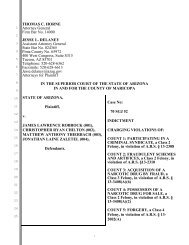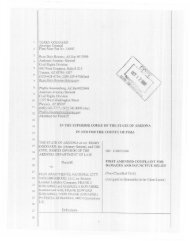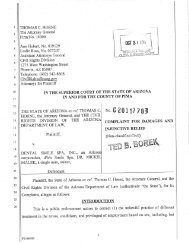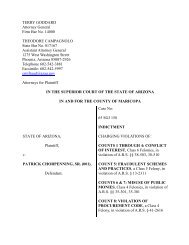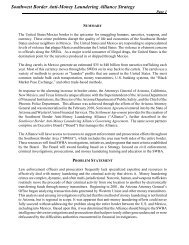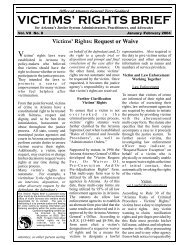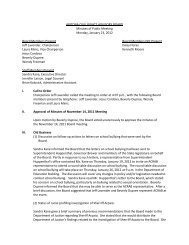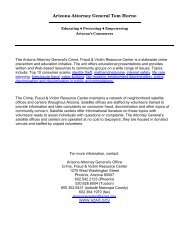II. Capital Punishment in Arizona History - Arizona Attorney General
II. Capital Punishment in Arizona History - Arizona Attorney General
II. Capital Punishment in Arizona History - Arizona Attorney General
Create successful ePaper yourself
Turn your PDF publications into a flip-book with our unique Google optimized e-Paper software.
was per se cruel and unusual punishment <strong>in</strong> Proffitt v. Florida, 428 U.S. 242 (1976). In Proffitt, theCourt held that the aggravat<strong>in</strong>g factor “especially he<strong>in</strong>ous, atrocious or cruel” was valid as applied,upheld Florida’s statutory procedures that required the consideration of specific aggravat<strong>in</strong>g andmitigat<strong>in</strong>g factors by the court, and the imposition of the death penalty only when aggravat<strong>in</strong>g factorsoutweigh mitigat<strong>in</strong>g factors. The <strong>Arizona</strong> death penalty statute, which provided for a procedure similarto that <strong>in</strong> Florida (separate guilt and penalty phases of the capital trial) was upheld as constitutional bythe <strong>Arizona</strong> Supreme Court <strong>in</strong> 1976 <strong>in</strong> State v. Richmond, 114 Ariz. 186, 560 P.2d. 41 (1976).In State v. Bishop, 118 Ariz. 263, 576 P.2d 122 (1978), the <strong>Arizona</strong> Supreme Court construed the list ofmitigat<strong>in</strong>g circumstances enumerated <strong>in</strong> A.R.S. § 13–703(G) to be exclusive. Shortly after the Bishopdecision, the Ohio statutory scheme limit<strong>in</strong>g the presentation of mitigation was found to be improper bythe United States Supreme Court <strong>in</strong> Lockett v. Ohio, 438 U.S. 586 (1978). The Court held that theEighth and Fourteenth Amendments require that the sentencer not be precluded from consider<strong>in</strong>g asmitigation any aspect of the defendant’s character or record, and any circumstance of the offense arguedby the defendant as mitigat<strong>in</strong>g the sentence to less than death. Consequently, the <strong>Arizona</strong> SupremeCourt <strong>in</strong> State v. Watson, 120 Ariz. 441, 586 P.2d. 1253 (1978), held <strong>Arizona</strong>’s death penalty statuteunconstitutional because of its limitation on the presentation of mitigation. However, the Court foundthat the unconstitutional portion of the statute was severable from the constitutional portion, and theCourt remanded the case to allow the defendant to present any circumstance show<strong>in</strong>g why the deathpenalty should not be imposed. After the Court’s decision <strong>in</strong> Watson, all prisoners on death row wereremanded for new sentenc<strong>in</strong>g hear<strong>in</strong>gs to allow presentation of any evidence tend<strong>in</strong>g to mitigate thesentence as described <strong>in</strong> Lockett.In 1979, follow<strong>in</strong>g the <strong>Arizona</strong> Supreme Court’s decision <strong>in</strong> Watson, the <strong>Arizona</strong> legislature amendedA.R.S. § 13–703(G) to allow either the State or the defendant to <strong>in</strong>troduce <strong>in</strong>to evidence any factorrelevant <strong>in</strong> determ<strong>in</strong><strong>in</strong>g whether to impose a sentence less than death. In 1993, A.R.S. § 13–703(A) wasamended to provide for a sentence of natural life, as an alternative to life imprisonment with theopportunity for parole after 25 years <strong>in</strong> prison.In Adamson v. Ricketts, 865 F.2d 1011 (9 th Cir. 1988), the United States Court of Appeals for the N<strong>in</strong>thCircuit ruled that the <strong>Arizona</strong> death penalty statute was unconstitutional as imposed. The court’s rul<strong>in</strong>gwas based on a denial of the defendant’s right to jury sentenc<strong>in</strong>g, the arbitrar<strong>in</strong>ess of the aggravat<strong>in</strong>gcircumstance of “especially he<strong>in</strong>ous, cruel or depraved,” the limitation on the sentenc<strong>in</strong>g court’sconsideration of mitigat<strong>in</strong>g circumstances, and the statutory presumption of death. The United StatesSupreme Court denied certiorari <strong>in</strong> Adamson, but granted review <strong>in</strong> Walton v. <strong>Arizona</strong>, 497 U.S. 639(1990), to address similar issues. In Walton, the Court upheld <strong>Arizona</strong>’s death penalty statute andspecifically ruled that a judge, rather than a jury, can f<strong>in</strong>d aggravat<strong>in</strong>g circumstances and that the“especially he<strong>in</strong>ous, cruel or depraved” circumstance provided sufficient guidance to satisfy the Eighthand Fourteenth Amendments.In R<strong>in</strong>g v. <strong>Arizona</strong>, 122 S. Ct. 2428 (2002), the United States Supreme Court overruled Walton to theextent that it authorized a judge, rather than a jury, to determ<strong>in</strong>e aggravat<strong>in</strong>g circumstances that subjectthe defendant to the death penalty. In response to R<strong>in</strong>g, the <strong>Arizona</strong> legislature enacted a new deathpenalty sentenc<strong>in</strong>g statute (Attachment “E”) that provides for jury sentenc<strong>in</strong>g <strong>in</strong> capital cases.The <strong>Capital</strong> CaseIn <strong>Arizona</strong>, the death penalty may only be imposed for first-degree premeditated or felony murder. Theprosecut<strong>in</strong>g agency handl<strong>in</strong>g the case must, with<strong>in</strong> sixty days of the arraignment of the defendant, file a
notice of <strong>in</strong>tent to seek the death penalty under Rule 15.1(g)(1) of the <strong>Arizona</strong> Rules of Crim<strong>in</strong>alProcedure.In determ<strong>in</strong><strong>in</strong>g whether to seek the death penalty the prosecutor may weigh many factors <strong>in</strong> addition tostatutory mitigat<strong>in</strong>g factors enumerated <strong>in</strong> A.R.S. § 13–703(G). The prosecutor may also consider nonstatutorymitigation <strong>in</strong>formation offered by the defendant, his family or his counsel, and <strong>in</strong>formationoffered by the victim’s family.Trial ProcessAlthough capital murder trials are similar to any other felony trial, there are some dist<strong>in</strong>ct differences.The trial of a capital case is divided <strong>in</strong>to two separate proceed<strong>in</strong>gs. The first is the guilt phase of thetrial, at which the prosecutor presents factual evidence as to the defendant’s guilt for the murder. Thesecond phase is the sentenc<strong>in</strong>g proceed<strong>in</strong>g, at which statutory aggravat<strong>in</strong>g circumstances is required tobe proved beyond a reasonable doubt. If that requirement is met, the aggravat<strong>in</strong>g circumstances areweighed aga<strong>in</strong>st any mitigation evidence proffered on the defendant’s behalf.Guilt PhaseOnce the prosecut<strong>in</strong>g agency has filed the notice of <strong>in</strong>tent to seek the death penalty, the defendant isassigned a second defense counsel under Rule 6.2 of the <strong>Arizona</strong> Rules of Crim<strong>in</strong>al Procedure. Onlyattorneys meet<strong>in</strong>g the heightened experience and skill standard set forth <strong>in</strong> Rule 6.8 of the <strong>Arizona</strong> Rulesof Crim<strong>in</strong>al Procedure can be appo<strong>in</strong>ted to represent a defendant <strong>in</strong> a capital case. However, thedefendant is free to reta<strong>in</strong> counsel of his own choos<strong>in</strong>g.In a capital trial, jurors may be “death qualified.” This refers to the process of question<strong>in</strong>g prospectivejurors on their views of the death penalty and their ability to follow the trial court’s <strong>in</strong>structions <strong>in</strong> lightof those views. In this process, jurors may be removed for cause if their opposition to the death penaltywill not allow them to apply the law or view the facts impartially. Jurors who are opposed to the deathpenalty will not be removed for cause if they avow that they will conscientiously apply the law to thefacts of the case.Once the capital murder trial has begun, it proceeds much like any other first-degree murder trial. Therules of crim<strong>in</strong>al procedure and the rules of evidence apply <strong>in</strong> the same way they do <strong>in</strong> all other crim<strong>in</strong>altrials.Sentenc<strong>in</strong>g PhasePrior to August, 2002, sentenc<strong>in</strong>g was handled entirely by the trial judge without jury <strong>in</strong>put. Theprosecutor presented evidence regard<strong>in</strong>g statutory aggravat<strong>in</strong>g circumstances and the defense presentedevidence of mitigat<strong>in</strong>g circumstances. (The prosecutor could also present evidence of mitigation.) Thetrial court was also permitted to consider “victim impact” evidence. At the conclusion of the evidence,the trial judge issued a Special Verdict, detail<strong>in</strong>g f<strong>in</strong>d<strong>in</strong>gs regard<strong>in</strong>g aggravat<strong>in</strong>g and mitigat<strong>in</strong>gcircumstances, and sett<strong>in</strong>g forth the sentence to be imposed.
With the enactment of <strong>Arizona</strong>’s new death penalty statute, the sentenc<strong>in</strong>g process now has two phases.In the first phase, the prosecutor presents evidence relat<strong>in</strong>g to aggravat<strong>in</strong>g circumstances. If the jurydeterm<strong>in</strong>es that the State has not established at least one statutory aggravat<strong>in</strong>g circumstance, thedefendant is no longer subject to the death penalty. The jury is dismissed and the trial judge decides theappropriate sentence. If the jury f<strong>in</strong>ds that there is at least one aggravat<strong>in</strong>g circumstance, the juryrema<strong>in</strong>s empaneled and considers any mitigat<strong>in</strong>g evidence presented by the defense or by the State, aswell as victim impact evidence. The jurors then decide whether to impose a death sentence, assess<strong>in</strong>gwhether the proffered mitigation is sufficiently substantial to warrant leniency.Appeals ProcessDirect AppealDeath penalty cases are automatically appealed to the <strong>Arizona</strong> Supreme Court. Prior to the enactment of<strong>Arizona</strong>’s new death penalty sentenc<strong>in</strong>g statute, the Court <strong>in</strong>dependently reviewed the propriety of thedeath sentence. Under the new statute, the <strong>Arizona</strong> Supreme Court reviews the conviction and sentencefor error, but does not <strong>in</strong>dependently determ<strong>in</strong>e whether to impose a death sentence.Prior to State v. White, 168 Ariz. 500, 815 P.2d. 869 (1991), the <strong>Arizona</strong> Supreme Court engaged <strong>in</strong> aproportionality review of each case to determ<strong>in</strong>e whether the death penalty was excessive ordisproportionate. This review is not constitutionally required and the Court no longer conducts such areview.To the extent that the rul<strong>in</strong>g of the <strong>Arizona</strong> Supreme Court addresses a federal constitutional issue,either of the parties can appeal a decision of that court directly to the United States Supreme Court bypetition<strong>in</strong>g for a writ of certiorari.Post-Conviction ReliefImmediately follow<strong>in</strong>g the f<strong>in</strong>al conclusion of the direct appeal to the <strong>Arizona</strong> Supreme Court, postconvictionrelief (PCR) proceed<strong>in</strong>gs are <strong>in</strong>itiated <strong>in</strong> the trial court. Post-conviction relief proceed<strong>in</strong>gsallow the defendant to raise claims relat<strong>in</strong>g primarily to whether: (1) trial counsel provided effectiverepresentation dur<strong>in</strong>g the trial and sentenc<strong>in</strong>g hear<strong>in</strong>g; (2) there is “newly-discovered” evidence thatwould have changed the verdict or sentence had it been presented at the time of trial; and (3) a change <strong>in</strong>the law that applies retroactively would probably change the conviction or sentence.The trial court’s decision on the post-conviction relief claims can be appealed to the <strong>Arizona</strong> SupremeCourt by either party, and the parties may file a petition for writ of certiorari request<strong>in</strong>g the UnitedStates Supreme Court to review the decision of the <strong>Arizona</strong> Supreme Court.Federal Habeas CorpusUnder 28 U.S.C. § 2254, a state prisoner may seek relief <strong>in</strong> federal district court on claims that hisfederal constitutional rights were violated at trial or at sentenc<strong>in</strong>g. A federal constitutional claim mayonly be raised <strong>in</strong> federal court if it has first been raised <strong>in</strong> a procedurally appropriate manner <strong>in</strong> statecourt. Dur<strong>in</strong>g the federal habeas corpus proceed<strong>in</strong>g, the federal court decides if the state court rul<strong>in</strong>gconflicts with controll<strong>in</strong>g United States Supreme Court authority.
If the prisoner’s claim was not properly presented <strong>in</strong> state court, he can still pursue the claim <strong>in</strong> federalcourt if he establishes “cause and prejudice” for his failure to present the claim <strong>in</strong> state court or thatfailure to consider the claim would result <strong>in</strong> a “fundamental miscarriage of justice,” based on actual<strong>in</strong>nocence or <strong>in</strong>eligibility for the death penalty.The decision of the United States District Court may be appealed by either party. The appeal from theUnited States District Court is taken to the United States Court of Appeals for the N<strong>in</strong>th Circuit, and theparties may seek review of the decision of that court by fil<strong>in</strong>g a petition for writ of certiorari with theUnited States Supreme Court.ExecutionThe <strong>in</strong>itial warrant of execution is issued by the <strong>Arizona</strong> Supreme Court to the Director of theDepartment of Corrections after the Court has affirmed the death sentence and either the first PCRproceed<strong>in</strong>g is concluded or the period of time to file the PCR petition has expired. The warrantdesignates a twenty-four hour period for execution of the sentence between thirty-five and sixty daysfollow<strong>in</strong>g the issuance of the warrant. If the <strong>in</strong>itial warrant is stayed by any court, the <strong>Arizona</strong> SupremeCourt is required to issue a subsequent warrant upon the State’s request after the stay is lifted. Stays ofexecution will not be issued upon the fil<strong>in</strong>g of subsequent PCR petitions, except upon separateapplication for a stay made to the <strong>Arizona</strong> Supreme Court. The separate application must set forthparticular issues appropriate for a successive PCR petition.In 1992, a constitutional amendment was passed by <strong>Arizona</strong> voters chang<strong>in</strong>g the method of executionfrom lethal gas to lethal <strong>in</strong>jection. Prisoners sentenced before November 23, 1992, have the choice ofeither lethal gas or lethal <strong>in</strong>jection.Competency to be ExecutedIn <strong>Arizona</strong>, a prisoner is not subject to execution if found to be mentally <strong>in</strong>competent or pregnant. Aprisoner is not competent to be executed unless the prisoner understands that (1) he/she is be<strong>in</strong>gpunished for murder, and (2) the punishment is death.If the court f<strong>in</strong>ds that the prisoner is <strong>in</strong>competent, he/she rema<strong>in</strong>s <strong>in</strong> the custody of the Department ofCorrections until the <strong>Arizona</strong> Supreme Court reviews the trial court’s f<strong>in</strong>d<strong>in</strong>g. If the supreme courtupholds the f<strong>in</strong>d<strong>in</strong>g of the trial court, the prisoner is transferred to a licensed behavioral health or mentalhealth facility operated by the Department of Corrections for competency restoration treatment. Whilethe prisoner is be<strong>in</strong>g treated, the sentence is suspended.The Department of Health Services is responsible for the restoration of competency treatment of theprisoner. Dur<strong>in</strong>g treatment, the chief medical officer of the State Hospital is required to file statusreports with the superior court at sixty-day <strong>in</strong>tervals until competency is restored. When the Departmentof Health Services believed the prisoner has been restored to competency, the prisoner is entitled to ahear<strong>in</strong>g <strong>in</strong> the trial court to address the competency issue. Once there is a f<strong>in</strong>d<strong>in</strong>g that the prisoner hasbeen restored to competency, the <strong>Arizona</strong> Supreme Court orders the issuance of a death warrant.
ClemencyThe <strong>Arizona</strong> Board of Executive Clemency is a five member panel appo<strong>in</strong>ted by the governor andconfirmed by the State Senate. The Board reviews all death sentences and determ<strong>in</strong>es whether torecommend to the governor reprieve, commutation or pardon, or to make no recommendation at all.The Board conducts a hear<strong>in</strong>g <strong>in</strong> which the defendant and his attorney, the State’s attorneys, and thevictim’s family and friends, as well as the public, are allowed to participate and provide statementsregard<strong>in</strong>g the prisoner and the crime.If the Board recommends reprieve, commutation or pardon, the governor then has constitutionalauthority to grant the recommended relief to the prisoner. The governor may only take such action upona recommendation by the Board.


